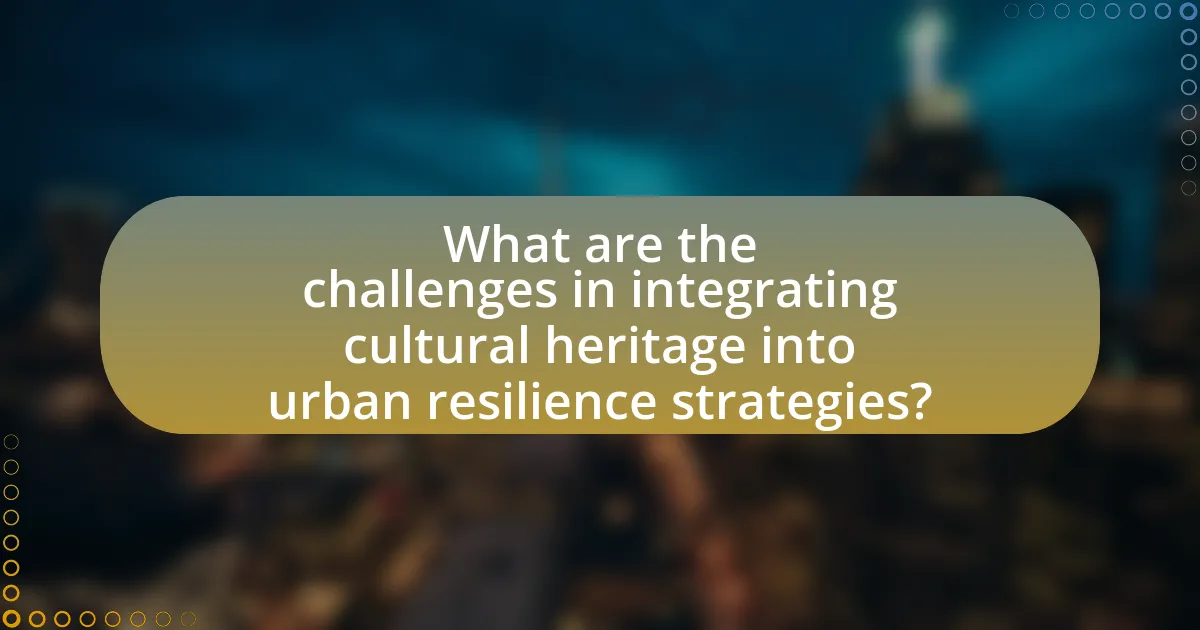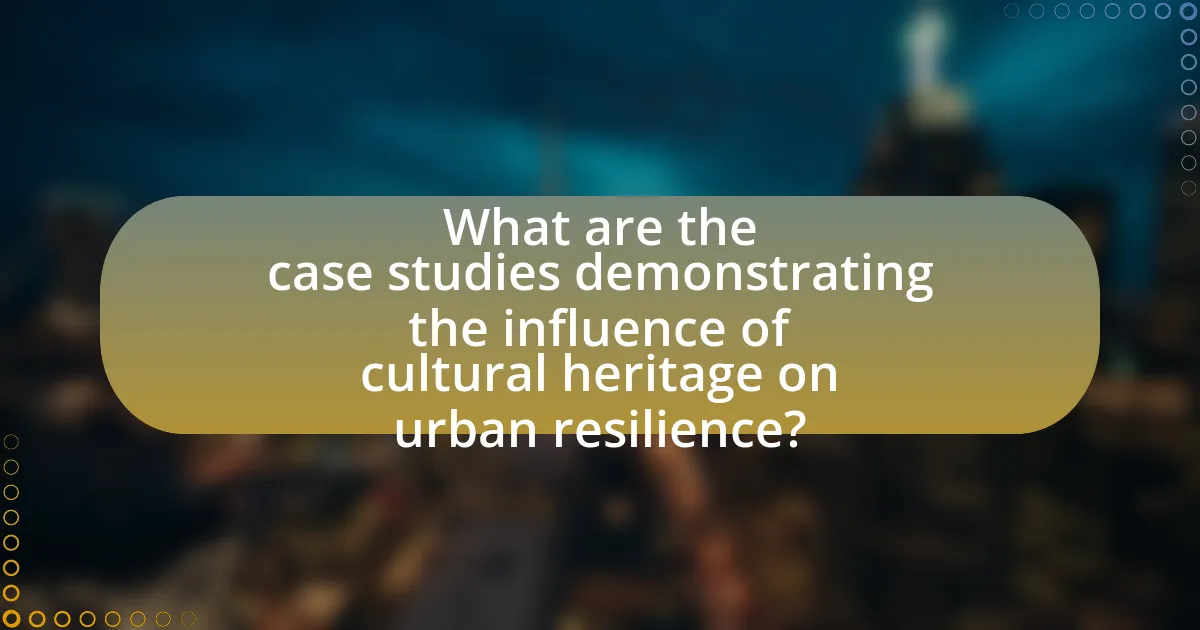The article examines the influence of cultural heritage on urban resilience, highlighting how it fosters community identity, social cohesion, and adaptive capacity in cities. It discusses key elements such as historical architecture, traditional practices, and local knowledge that enhance collective responses to crises. The article also addresses the challenges of integrating cultural heritage into urban planning, including financial constraints and urban development pressures, while presenting successful case studies that demonstrate the positive impact of cultural heritage on community resilience and disaster preparedness. Additionally, it outlines best practices for policymakers and communities to leverage cultural heritage in enhancing urban resilience.

What is the Influence of Cultural Heritage on Urban Resilience?
Cultural heritage significantly influences urban resilience by fostering community identity, social cohesion, and adaptive capacity. This influence is evident as cities with rich cultural heritage often exhibit stronger community ties, which enhance collective responses to challenges such as natural disasters or economic shifts. For instance, research conducted by the United Nations Educational, Scientific and Cultural Organization (UNESCO) highlights that communities with a strong sense of cultural identity are more likely to engage in collaborative recovery efforts, thereby improving resilience outcomes. Furthermore, cultural heritage sites can serve as focal points for community gatherings and resource mobilization during crises, reinforcing the social fabric essential for resilience.
How does cultural heritage contribute to urban resilience?
Cultural heritage contributes to urban resilience by fostering community identity and social cohesion, which are essential for collective action during crises. When communities engage with their cultural heritage, they develop a sense of belonging and shared values, enabling them to respond more effectively to challenges such as natural disasters or economic downturns. For instance, research by the United Nations Educational, Scientific and Cultural Organization (UNESCO) highlights that cities with strong cultural heritage frameworks are better equipped to recover from shocks, as they leverage local knowledge and traditions in their resilience strategies. This connection between cultural heritage and urban resilience is evident in cities like Kyoto, Japan, where preservation of cultural sites has not only maintained tourism but also strengthened community ties, facilitating quicker recovery after events like earthquakes.
What are the key elements of cultural heritage that impact urban resilience?
The key elements of cultural heritage that impact urban resilience include historical architecture, traditional practices, community identity, and local knowledge. Historical architecture provides structural integrity and cultural significance, which can enhance community cohesion during crises. Traditional practices, such as festivals and rituals, foster social networks that are crucial for collective action in emergencies. Community identity, rooted in shared history and values, strengthens social bonds and encourages collaborative resilience efforts. Local knowledge, encompassing environmental understanding and adaptive strategies, equips communities to respond effectively to challenges. These elements collectively contribute to a city’s ability to withstand and recover from adverse events, as evidenced by case studies showing that cities with strong cultural heritage often exhibit greater social capital and resourcefulness in times of crisis.
How do historical sites and traditions enhance community cohesion?
Historical sites and traditions enhance community cohesion by providing shared spaces and experiences that foster a sense of belonging among residents. These sites serve as focal points for community gatherings, celebrations, and educational activities, which strengthen social ties. For example, research conducted by the National Trust for Historic Preservation indicates that communities with active historical sites report higher levels of civic engagement and social interaction. Additionally, traditions linked to these sites, such as festivals or commemorative events, create opportunities for residents to connect with one another, reinforcing communal identity and solidarity.
Why is understanding this influence important for urban planning?
Understanding the influence of cultural heritage on urban resilience is crucial for urban planning because it informs the integration of historical and cultural contexts into development strategies. This integration enhances community identity, fosters social cohesion, and promotes sustainable practices that respect local traditions. Research indicates that cities that incorporate cultural heritage into their planning processes are better equipped to withstand and recover from environmental and social challenges, as evidenced by case studies in cities like Kyoto, Japan, where heritage preservation has contributed to both tourism and community resilience.
What role does cultural heritage play in disaster preparedness?
Cultural heritage plays a crucial role in disaster preparedness by fostering community identity and resilience. It enhances social cohesion, enabling communities to collaborate effectively during crises. For instance, communities with strong cultural ties are more likely to engage in collective risk reduction strategies, as evidenced by the 2011 Great East Japan Earthquake, where local cultural practices facilitated quicker recovery efforts. Furthermore, integrating cultural heritage into disaster planning can help preserve historical sites and traditions, ensuring that recovery efforts respect and maintain community values. This approach not only aids in immediate response but also strengthens long-term resilience against future disasters.
How can cultural heritage inform sustainable urban development?
Cultural heritage can inform sustainable urban development by providing a framework for integrating historical context, community identity, and environmental stewardship into urban planning. This integration fosters a sense of place and belonging, which can enhance community engagement and support for sustainable initiatives. For instance, cities that preserve historical sites and incorporate traditional architectural styles often experience increased tourism and local economic benefits, as seen in cities like Florence, Italy, where heritage conservation has led to sustainable tourism practices that respect local culture while promoting economic growth. Additionally, cultural heritage can guide the development of green spaces and public areas that reflect local traditions, thereby improving urban resilience against climate change impacts.

What are the challenges in integrating cultural heritage into urban resilience strategies?
Integrating cultural heritage into urban resilience strategies faces several challenges, primarily due to conflicting priorities between development and preservation. Urban planners often prioritize economic growth and infrastructure development, which can lead to the neglect of cultural sites. Additionally, there is a lack of comprehensive frameworks that effectively incorporate cultural heritage into resilience planning, resulting in fragmented approaches. Furthermore, community engagement is often insufficient, as local populations may not be adequately involved in decision-making processes regarding their cultural assets. Studies, such as those by the United Nations Educational, Scientific and Cultural Organization (UNESCO), highlight that without proper integration, cultural heritage can be at risk during urban development and disaster response efforts, undermining both community identity and resilience.
What obstacles do cities face when preserving cultural heritage?
Cities face significant obstacles when preserving cultural heritage, including financial constraints, urban development pressures, and lack of public awareness. Financial constraints often limit the resources available for restoration and maintenance of heritage sites, as cities prioritize immediate economic needs over long-term cultural investments. Urban development pressures arise from the demand for new infrastructure and housing, which can lead to the demolition or alteration of historic sites. Additionally, a lack of public awareness and appreciation for cultural heritage can result in insufficient community support for preservation efforts, making it challenging to mobilize resources and advocacy for these initiatives. These factors collectively hinder effective preservation strategies and threaten the integrity of cultural heritage in urban environments.
How do economic factors affect the preservation of cultural sites?
Economic factors significantly influence the preservation of cultural sites by determining the availability of funding and resources necessary for maintenance and restoration. For instance, regions with strong economic performance can allocate more financial resources to heritage conservation projects, leading to better preservation outcomes. Conversely, areas facing economic decline often struggle to secure funding, resulting in neglect and deterioration of cultural sites. According to a report by UNESCO, countries that invest at least 1% of their GDP in cultural heritage see improved preservation rates and enhanced tourism, which further supports local economies. This correlation illustrates how economic stability directly impacts the ability to maintain and protect cultural heritage, thereby affecting urban resilience.
What are the social implications of neglecting cultural heritage in urban planning?
Neglecting cultural heritage in urban planning leads to social fragmentation and loss of community identity. When urban planners overlook historical sites and cultural landmarks, they diminish the sense of belonging among residents, which can result in decreased social cohesion. Studies indicate that communities with strong cultural heritage tend to exhibit higher levels of social trust and engagement. For instance, research by the European Commission highlights that cities preserving their cultural heritage experience greater community participation and resilience during crises. Thus, the absence of cultural heritage in urban planning not only erodes local identity but also weakens the social fabric essential for community resilience.
How can cities overcome these challenges?
Cities can overcome challenges related to cultural heritage and urban resilience by integrating heritage preservation into urban planning and development strategies. This approach ensures that cultural assets are recognized as vital components of community identity and economic vitality. For instance, cities like Barcelona have successfully implemented policies that promote the conservation of historical sites while encouraging sustainable tourism, which contributes to local economies. Additionally, engaging communities in the decision-making process fosters a sense of ownership and responsibility towards cultural heritage, enhancing social cohesion and resilience. Studies show that cities that prioritize cultural heritage in their resilience strategies are better equipped to adapt to environmental and social changes, as evidenced by the resilience frameworks developed in cities such as Kyoto and Istanbul.
What best practices exist for integrating cultural heritage into urban resilience frameworks?
Best practices for integrating cultural heritage into urban resilience frameworks include participatory planning, adaptive reuse of historic structures, and the incorporation of traditional knowledge. Participatory planning engages local communities in decision-making, ensuring that cultural values are preserved and reflected in resilience strategies. Adaptive reuse of historic structures not only conserves cultural heritage but also enhances urban sustainability by reducing waste and resource consumption. Incorporating traditional knowledge allows for the integration of time-tested practices that can enhance community resilience to environmental changes. These practices are supported by case studies, such as the UNESCO’s “Heritage and Resilience” initiative, which highlights successful examples of cultural heritage integration in urban resilience planning worldwide.
How can community engagement enhance the preservation of cultural heritage?
Community engagement enhances the preservation of cultural heritage by fostering local ownership and participation in heritage initiatives. When communities actively participate, they contribute their knowledge, traditions, and values, which strengthens the relevance and authenticity of cultural heritage practices. For instance, studies have shown that community-led heritage projects, such as local festivals or restoration efforts, can increase public awareness and appreciation, leading to greater support for preservation efforts. Research by the International Council on Monuments and Sites indicates that involving local populations in decision-making processes results in more sustainable and effective heritage conservation strategies.

What are the case studies demonstrating the influence of cultural heritage on urban resilience?
Case studies demonstrating the influence of cultural heritage on urban resilience include the restoration of the historic city of Dubrovnik, Croatia, after the 1991 war, which emphasized the importance of preserving cultural identity while rebuilding infrastructure. This approach not only revitalized the economy through tourism but also strengthened community ties and local governance. Another example is the post-earthquake recovery of L’Aquila, Italy, where integrating cultural heritage into reconstruction efforts helped maintain social cohesion and fostered a sense of belonging among residents. These cases illustrate that leveraging cultural heritage can enhance urban resilience by promoting economic recovery and community engagement.
What successful examples exist globally?
Successful examples of the influence of cultural heritage on urban resilience include the restoration of the historic city of Dubrovnik in Croatia and the preservation efforts in Kyoto, Japan. Dubrovnik, after suffering damage during the Croatian War of Independence, implemented a comprehensive restoration plan that not only rebuilt its historic structures but also enhanced its infrastructure, leading to increased tourism and economic stability. Similarly, Kyoto has maintained its cultural heritage through strict regulations on urban development, which has helped the city withstand natural disasters while preserving its historical identity. These examples demonstrate how integrating cultural heritage into urban planning can enhance resilience and sustainability.
How did specific cities leverage their cultural heritage during crises?
Cities such as Florence and New Orleans effectively leveraged their cultural heritage during crises by utilizing their historical assets to foster community resilience and economic recovery. Florence, during the COVID-19 pandemic, promoted its rich artistic heritage through virtual tours and online exhibitions, which not only kept the cultural sector alive but also engaged global audiences, generating revenue and maintaining cultural relevance. Similarly, New Orleans harnessed its vibrant music and festival culture post-Hurricane Katrina by revitalizing local traditions and events, which played a crucial role in community rebuilding and attracting tourism, evidenced by the resurgence of events like Jazz Fest that celebrate the city’s unique cultural identity. These strategies demonstrate how cities can utilize their cultural heritage as a tool for resilience in the face of adversity.
What lessons can be learned from these case studies?
Lessons learned from these case studies include the importance of integrating cultural heritage into urban resilience strategies. Case studies demonstrate that cities that leverage their cultural assets can enhance community identity and social cohesion, which are critical for effective disaster response and recovery. For instance, research shows that communities with strong cultural ties are more likely to mobilize quickly during crises, as seen in post-disaster recovery efforts in cities like New Orleans after Hurricane Katrina. Additionally, preserving cultural heritage can provide economic benefits through tourism and local engagement, further strengthening urban resilience.
How do these examples inform future urban resilience strategies?
Examples of cultural heritage integration in urban resilience strategies demonstrate the importance of preserving historical assets while enhancing community adaptability. By analyzing case studies where cultural heritage sites have been successfully incorporated into disaster preparedness plans, urban planners can identify effective methods for leveraging local identity and community engagement. For instance, cities that have utilized heritage sites as emergency shelters or community gathering points during crises have shown improved social cohesion and resource sharing, which are critical for resilience. This evidence suggests that future urban resilience strategies should prioritize the inclusion of cultural heritage to foster community ties and enhance overall preparedness against environmental and social challenges.
What trends are emerging in the integration of cultural heritage and urban resilience?
Emerging trends in the integration of cultural heritage and urban resilience include the recognition of cultural heritage as a vital asset in disaster risk reduction and urban planning. Cities are increasingly adopting strategies that incorporate historical sites and local traditions into resilience frameworks, enhancing community identity and social cohesion. For instance, the UNESCO Resilient Cities initiative emphasizes the role of cultural heritage in fostering adaptive capacities among urban populations. Additionally, participatory approaches are gaining traction, where local communities are engaged in decision-making processes regarding the preservation of their cultural assets, thereby strengthening resilience against climate change impacts. These trends highlight a shift towards holistic urban development that values both cultural identity and resilience.
How can policymakers apply these insights to their local contexts?
Policymakers can apply insights from the influence of cultural heritage on urban resilience by integrating cultural preservation into urban planning and disaster management strategies. This approach recognizes that cultural heritage contributes to community identity and social cohesion, which are vital for resilience during crises. For instance, studies have shown that communities with strong cultural ties recover more quickly from disasters, as seen in post-earthquake recovery efforts in cities like L’Aquila, Italy, where cultural heritage initiatives facilitated community rebuilding. By prioritizing cultural heritage in policy frameworks, local governments can enhance community engagement, promote sustainable tourism, and foster economic development, ultimately leading to more resilient urban environments.
What practical steps can communities take to enhance urban resilience through cultural heritage?
Communities can enhance urban resilience through cultural heritage by actively preserving and promoting local historical sites and traditions. This preservation fosters a sense of identity and belonging, which strengthens social cohesion during crises. For instance, the UNESCO World Heritage designation has been shown to increase community engagement and investment in local heritage, leading to improved disaster preparedness and recovery strategies. Additionally, integrating cultural heritage into urban planning can create more sustainable environments, as seen in cities like Kyoto, where heritage conservation has been linked to economic resilience and tourism growth. By leveraging cultural heritage, communities can build a robust framework for resilience that supports both social and economic stability.


